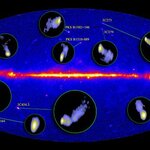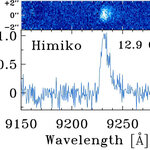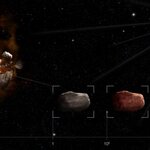Space

Back on a frozen pre-Inaugeration Day, I picked up a hitchhiker on US295N. We exchanged the usual banter ("Got any guns? No? Great!"). He wasn't a local, just in town to help assemble bandstands in DC and visiting a friend in Baltimore. He had three reasons for hitching that cold wintry day: his car had died, he had no money, and it made him feel like he was 17 again.
The strangest part was that he started talking about recent lack of sunspots, as seen by a NASA satellite mission and reported on spaceweather.com.
Now, what are the odds that an itinerant hitchhiker whose hobby is…

The Hubble Telescope was carried into orbit on this day, April 24th, back in
1990, which makes it 19 years old. Now it can finally legally drink alcohol in
Ontario!
The Hubble Space Telescope (HST) is a space telescope
that was carried into orbit by
the Space Shuttle Discovery in April 1990. It is named after the
American astronomer Edwin Hubble. Although not
the first space telescope, the Hubble is one of the largest and most versatile,
and is well-known as both a vital research tool and a public relations boon for
astronomy. The HST is a
collaboration between NASA and the European Space…

A process called ‘dark gulping’ may solve the mystery of the how supermassive black holes were able to form when the Universe was less than a billion years old.
Dr Curtis Saxton will be presenting the study at the European Week of Astronomy and Space Science at the University of Hertfordshire in Hatfield.
Dr Saxton and Professor Kinwah Wu, both of UCL’s Mullard Space Science Laboratory, developed a model to study the gravitational interactions between the invisible halo of dark matter in a cluster of galaxies and the gas embedded in the dark matter halo. They found that the interactions cause…

An international team of astronomers has used the world's biggest radio telescope to look deep into the brightest galaxies that NASA's Fermi Gamma-ray Space Telescope can see. The study solidifies the link between an active galaxy's gamma-ray emissions and its powerful radio-emitting jets.
"Now we know for sure that the fastest, most compact, and brightest jets we see with radio telescopes are the ones that are able to kick light up to the highest energies," said Yuri Kovalev, a team member at the Max Planck Institute for Radio Astronomy in Bonn, Germany.
The brightest galaxies Fermi…

Using information from a suite of telescopes, astronomers have discovered a mysterious, giant object that existed at a time when the universe was only about 800 million years old. Objects such as this one are dubbed extended Lyman-Alpha blobs; they are huge bodies of gas that may be precursors to galaxies. This blob was named Himiko for a legendary, mysterious Japanese queen. It stretches for 55 thousand light years, a record for that early point in time. That length is comparable to the radius of the Milky Way's disk.
The researchers, even with superb data from the world's best…

A new study reveals that asteroid surfaces age and redden much faster than previously thought — in less than a million years, the blink of an eye for an asteroid. The solar wind is the likely culprit in very rapid space weathering, they say, and this knowledge will help astronomers relate the appearance of an asteroid to its actual history and identify any after effects of a catastrophic impact with another asteroid.
It has long been known that asteroid surfaces alter in appearance with time. Observed asteroids are much redder than the interior of meteorites found on Earth; a…

Waves from Daphnis
Undulations mark both sides of the path of Saturn's moon Daphnis through the A ring.
Daphnis may be small at only 8 kilometers (5 miles) across, but the moon's gravity is great enough, and the Keeler gap in which it resides is narrow enough, so that the perturbed particles create the wavelike patterns seen here.
This view looks toward the unilluminated side of the rings from about 47 degrees above the ringplane. The image was taken in visible light with the Cassini spacecraft narrow-angle camera on Feb. 21, 2009. The view was acquired at a distance of…

"Kepler is like Field of Dreams meets Cosmos" says Padi Boyd, a scientist with the Kepler planet-hunting mission. This set the stage for an enjoyable short interview. Earlier I wrote why Kepler is awesomeness squared, and now we look at how the motivation of the people involved leads to better science success.
Kepler was conceived, proposed, and lead by Bill Borucki. It is NASA Discovery mission #10, designed to be low cost and focused towards one task. For Kepler, that's planet-hunting.
While principal investigators work with a mission pregame through wrapup, others-- such as Padi and (for…

A team of astronomers from University College London (UCL) have discovered that an exotic world passes directly in front of the Sun-like star it orbits, revealing for the first time that it is about the same size as Jupiter.
The team were alerted by the exoplanet science website http://www.oklo.org, run by Greg Laughlin of the University of California Santa Cruz. Using infrared space observations, Greg predicted that a planet (HD 80606b) would pass in front of its parent star (HD 80606) in a so-called transit event.
Rather than travelling to one of the major observatories in Hawaii or Chile…

Exoplanet researcher Michel Mayor today announced the discovery of the lightest exoplanet found so far. The planet, Gliese 581 e, in the famous system Gliese 581, is only about twice the mass of our Earth. The team also refined the orbit of the planet Gliese 581 d, first discovered in 2007, placing it well within the habitable zone, where liquid water oceans could exist.
These amazing discoveries are the outcome of more than four years of observations using the most successful low-mass-exoplanet hunter in the world, the HARPS spectrograph attached to the 3.6-meter ESO telescope at La Silla,…